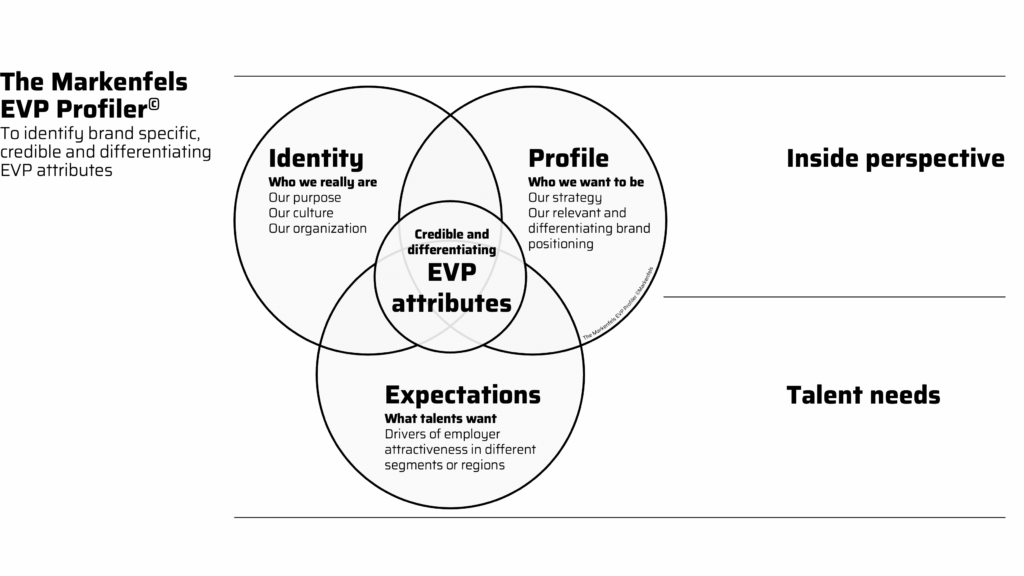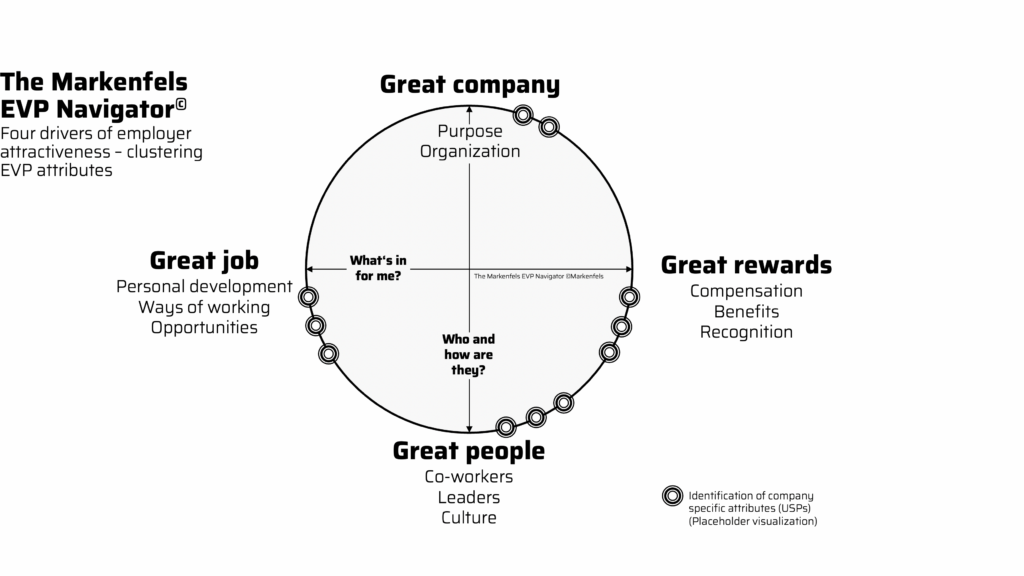Employer Branding
Attracting the best talent

Employer branding comprises the sum of all strategic and tangible elements that position a corporate brand as a strong employer brand. Foundation for successful employer branding is the consequent alignment of the employer brand strategy to the business strategy – and to talents expectations. The employer brand supports implementing the business strategy by attracting the right talents, for example for a growth strategy, or for pioneering innovation, or for internationalization, or for a transformation process.
Which steps are needed to develop a successful employer brand?
Step 1: development of the strategic foundation
A strong employer brand strategy ensures that the business strategy is translated into attractive communication with talents – and that the right talents are attracted to implement the business strategy. Competitors in the war for talent often come as a surprise, because talents do not choose between “peers” from similar business areas, but between startups and large corporates, or between pharma and tech.
The Employer Brand Strategy consists of three elements:
- Employer Value Proposition (EVP): a targeted selection of relevant and differentiating attribute clusters that define the brand-specific communication topics
- Employer Brand Story: a short and exciting story – along the EVP attribute clusters – to position the brand as an attractive employer
- Employer Brand Core Messages: a toolkit of core messages and proof points that convey the Employer Brand Story and EVP attribute clusters. Optional, an Employer Brand Tone of Voice: the brand-specific definition of vocabulary and language style
Which attributes are suitable for an Employer Value Proposition?
The attributes for a successful Employer Value Proposition (EVP) must be relevant and credible.
In order to identify them, it is worthwhile to first combine the internal view with the external view and identify the common denominators from the corporate identity, the desired perception, and the expectations of talents. Markenfels has developed the EVP Profiler for this purpose, which – in combination with a validated external view, e. g. market studies – provides an initial rough framework for the EVP attributes.

How does the strategic elaboration of the EVP attributes succeed?
In order to specifically elaborate the EVP attributes, Markenfels has developed the “Markenfels EVP Navigator”. The EVP Navigator helps to clarify how the company can position itself as a great company with great people, promising career prospects and attractive benefits. The development process explores the two key questions of talents: “What’s in it for me?” and “Who is this company?”. The aim of the development process is to identify those three to a maximum of four clusters that are able to position the company in a relevant, unique and credible way to the talents.

Step 2: Developing the Employer Brand Experience
The Employer Brand Strategy forms the basis for the development of the Employer Brand Experience. EVP, Employer Brand Story and Employer Brand Key Messages are translated into visual elements – within the framework of the overarching Brand Experience. These Employer Brand Design elements interact to create a coherent and intuitively perceivable experience that conveys the brand’s positioning as an employer.
To ensure successful implementation, the Employer Brand Experience must be system-capable, efficient and easy to use. This can be achieved by applying the basic elements of the actual brand identity to the employer brand without restriction. This includes the brand positioning, logo, brand colors, fonts, UX elements, website wireframes, etc.
What are specific challenges in employer branding?
HR departments and recruiters often rely on job descriptions but pay not enough attention to the emotional part of a decision for a company. On the other hand, branding departments often regard employer branding as second priority, even though talent needs are different from customer needs.
A successful employer branding process is therefore based on both perspectives and requires close collaboration between disciplines. HR experts (or People & Organization, as it is already called in many places) bring proven expertise on talent needs and expectations, recruiting needs and market-specific situations into the process. Branding experts ensure a professional employer brand experience that draws strength from the established corporate brand.
The biggest mistakes in employer branding:
- Holding on to traditional corporate culture. Companies in fierce competition with startups or tech companies must change themselves by fundamentally transforming the corporate culture and the way they work together.
- Pretending to have a culture that is not lived. Companies should not try to portray themselves differently in employer branding than they really are. It doesn’t help to breathe startup glamour into employer branding and promise agile working if the corporate reality is still traditional and hierarchical.
- Neglecting employer branding as a contribution to business success. Employer branding makes a significant contribution to business success: attracting the best talents strengthens the market position and the company’s success.











